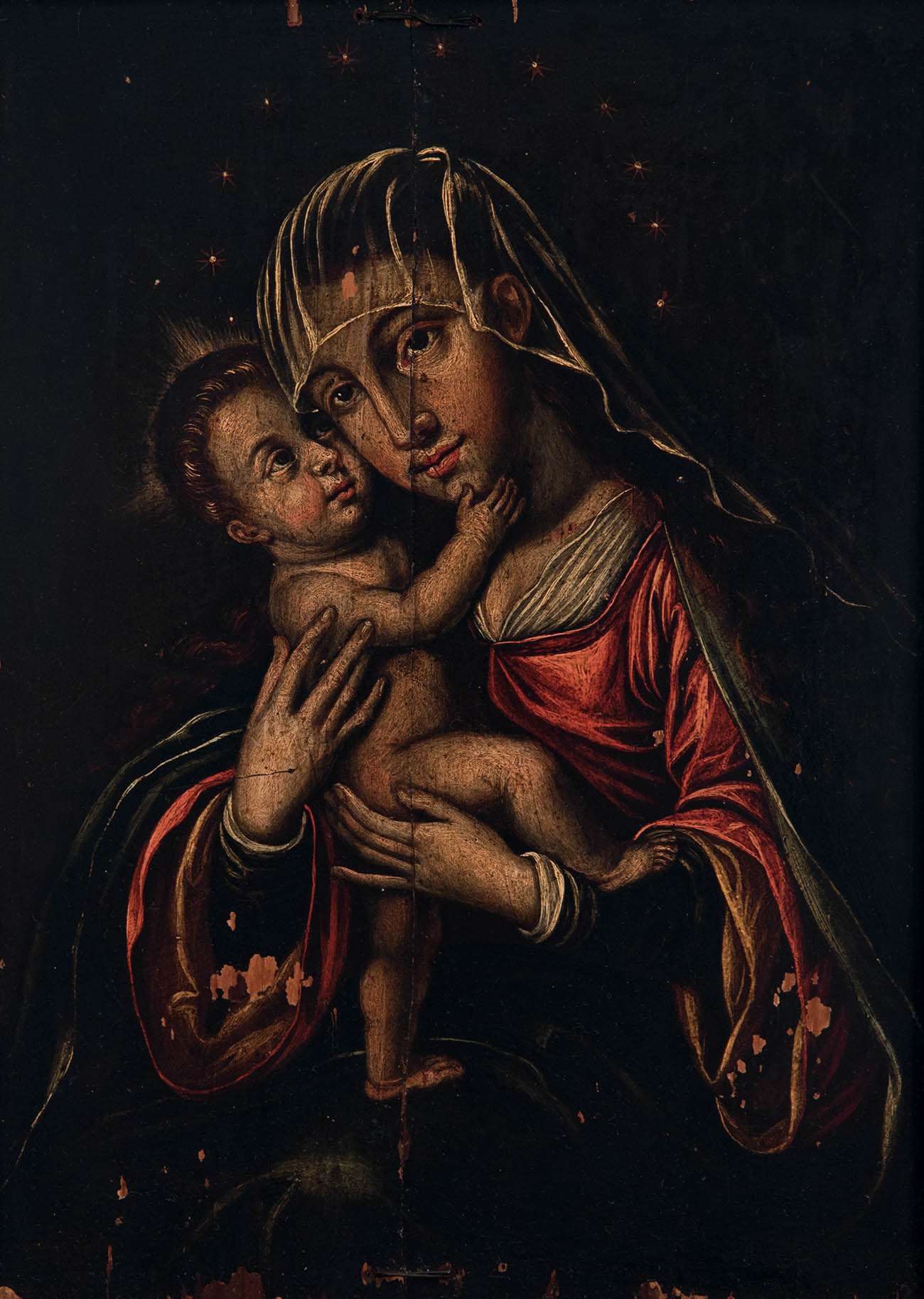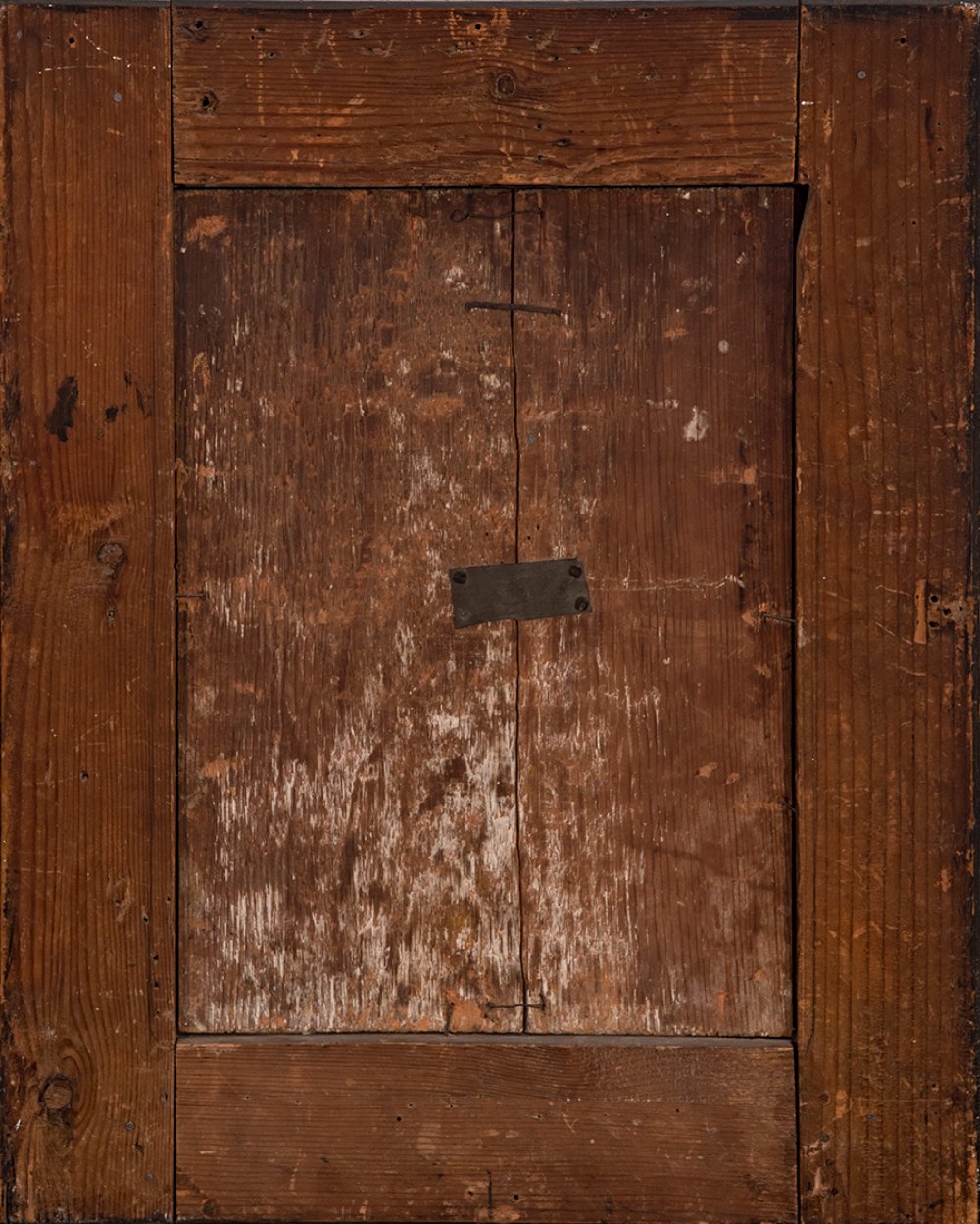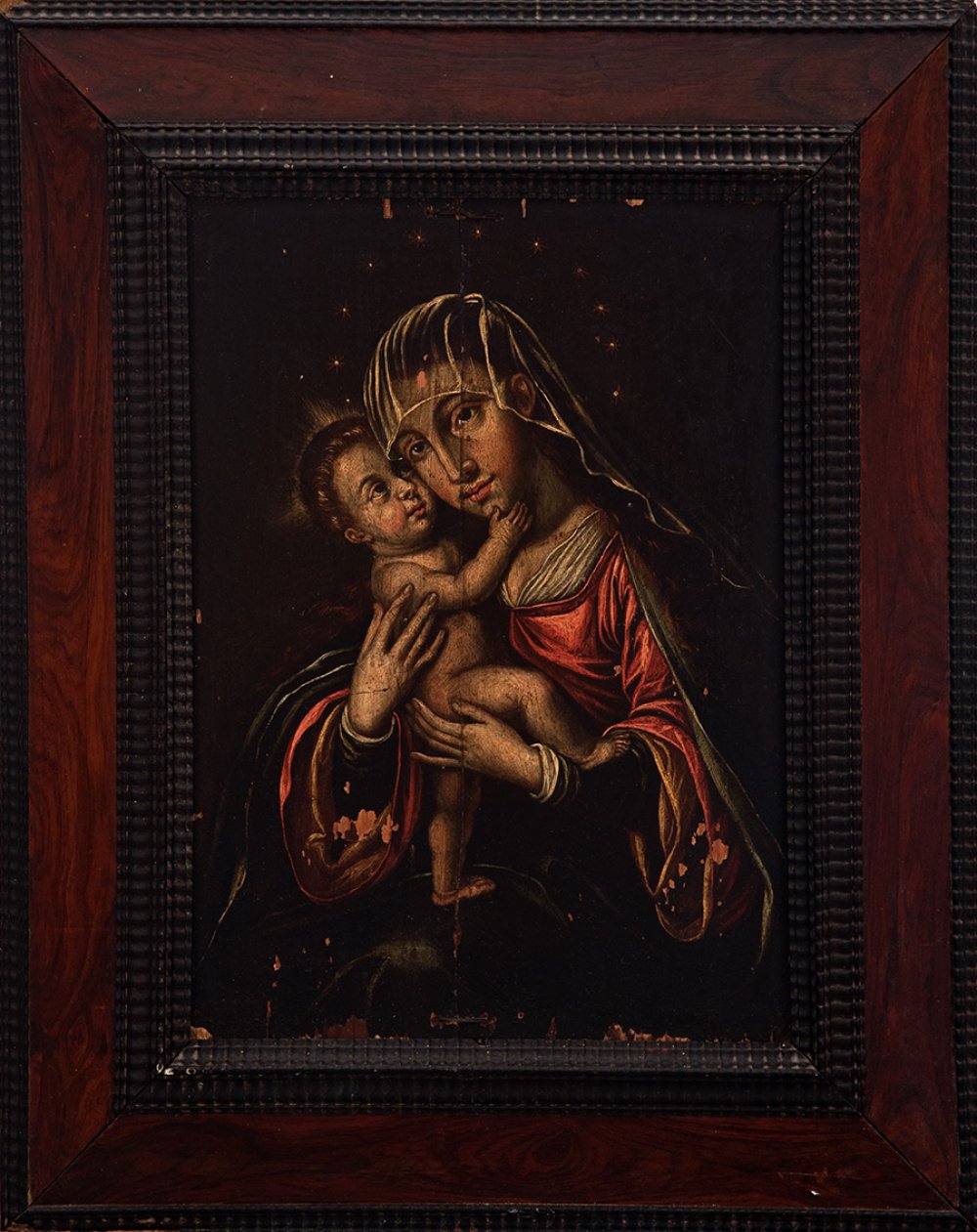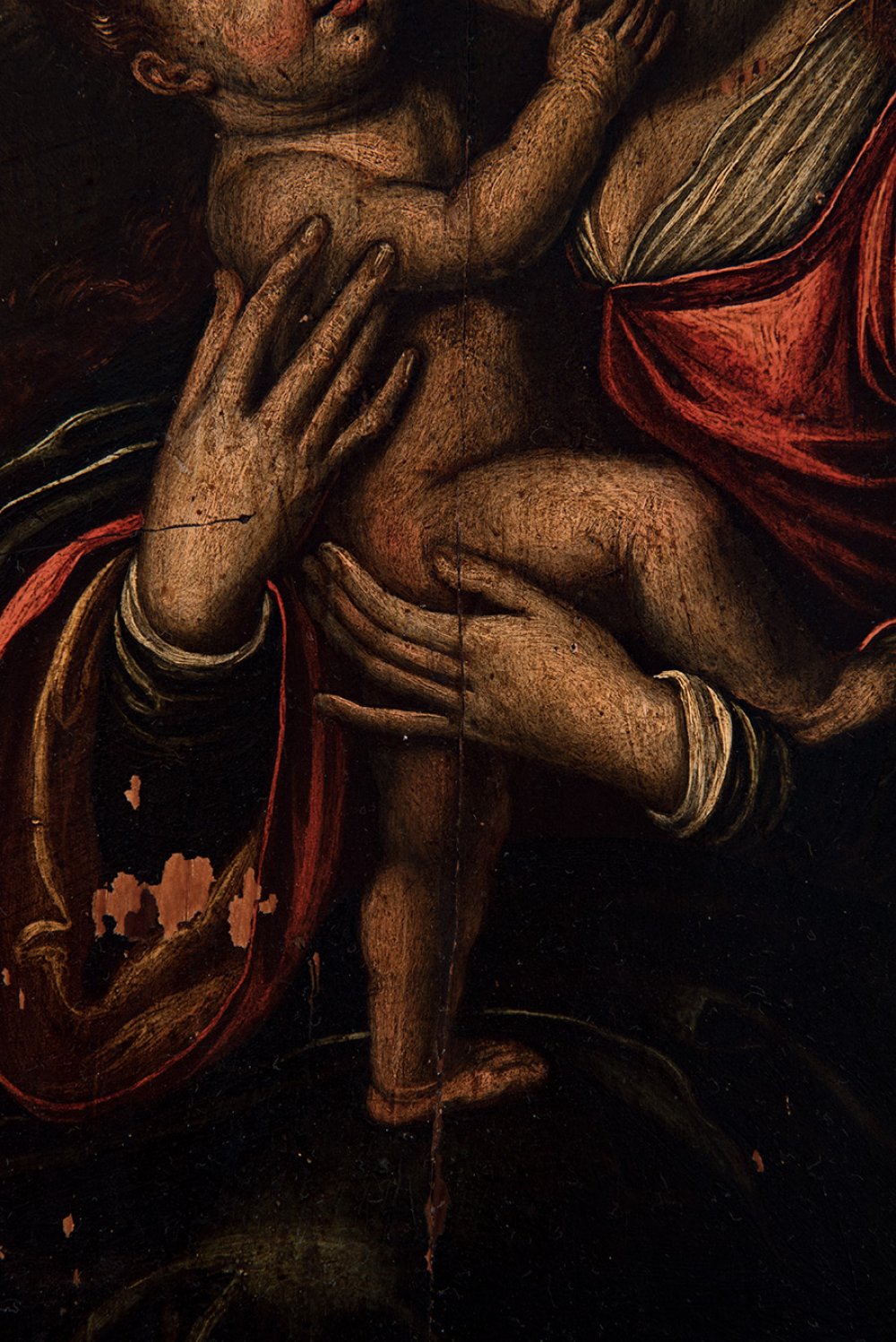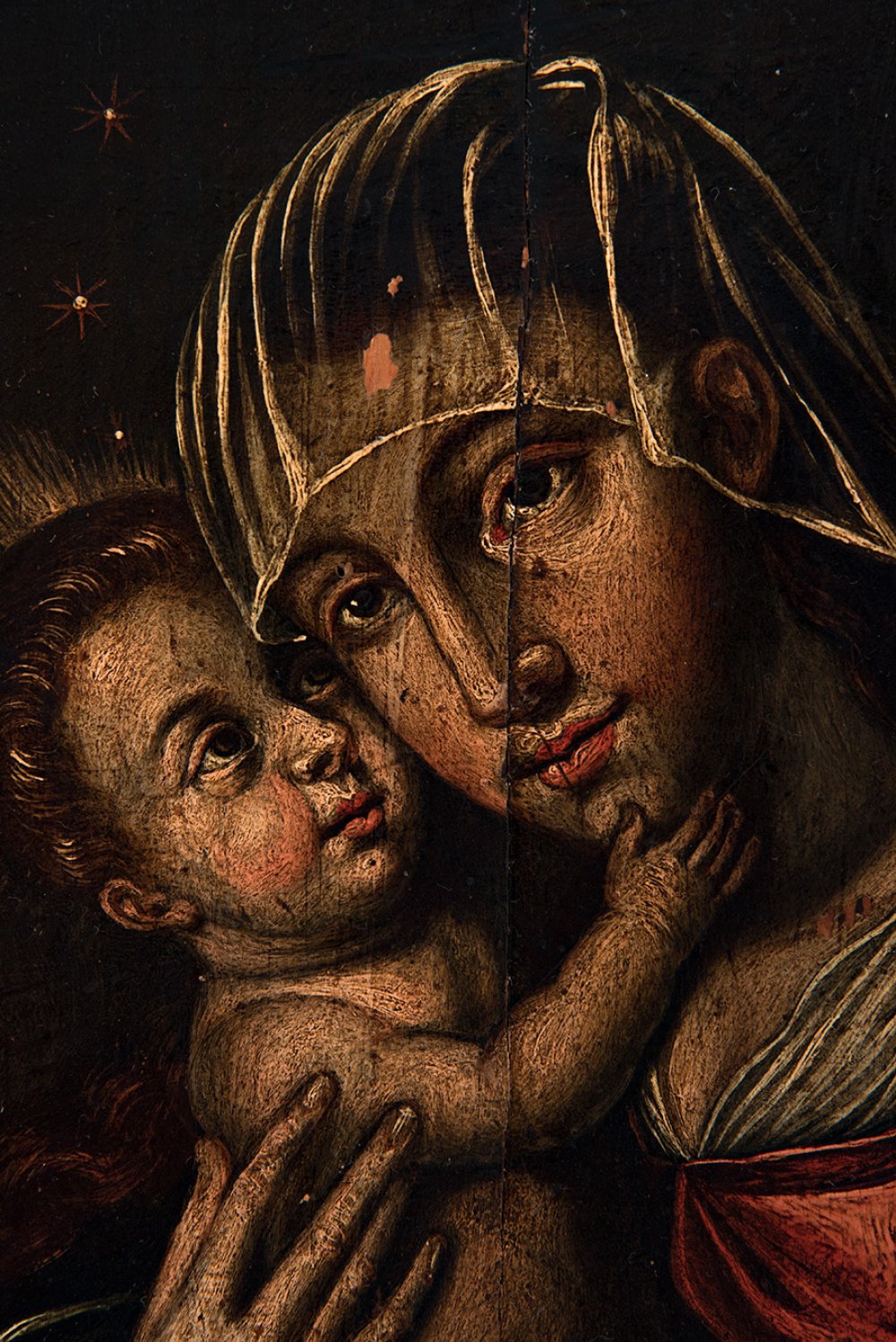42
Hispano-Flemish school; 16th century."Virgin and Child.Oil on panel.There is a break in the panel.
"Virgin and Child.
Oil on panel.
There is a break in the panel. The panel is reinforced with veneer and flakes.
It has faults and repainting.
Measurements: 37 x 26.5 cm; 53 x 42.5 cm (frame).
In the foreground is the image of Mary, dressed in a red tunic with her hair covered by a transparent cloth that lets you see through it. The Virgin is holding and holding the Child Jesus close to her cheek, who is placed in his mother's arms, completely naked and innocent, and moves one of his hands towards his mother's cheek, holding it gently. Jesus looks towards the Virgin, but she looks directly at the viewer as if warning that her son will be the saviour, the one who will sacrifice his life.
As is usual in the Flemish school, the attention to the quality of the fabrics and their colouring is particularly noteworthy. The composition is also very common in this style, deriving from the iconographic patterns established around the representation of the Virgin of the Milk, also known as the Nourishing Virgin, the Virgin of Repose or the Virgin of Bethlehem, a Marian iconography in which Mary is depicted breastfeeding the Child. It is based on the story of the Grotto of the Milk in Bethlehem, where tradition says that the Virgin suckled the Child, and a drop spilled on a rock, which changed its colour and turned white. However, iconographically, this is a very ancient theme, which has its origins in the mother goddesses of the ancient religions of the Near East and the Greco-Latin world: Isis with Horus, the Milky Way from Hera's milk, etc. This theme was incorporated into early Christian art, examples of which can be found as early as the 2nd century. In Byzantine art it received the name Galactotrofusa, and was a recurring theme in icons. In Latin Christianity the invocation became very popular in the last centuries of the Middle Ages. It was particularly frequent in the Sienese school of the Trecento, and soon spread throughout Western Europe. However, its representation was limited after the Council of Trent, for reasons of modesty, although Baroque painters continued to depict it, and it even reached the colonial schools.
"Virgin and Child.
Oil on panel.
There is a break in the panel. The panel is reinforced with veneer and flakes.
It has faults and repainting.
Measurements: 37 x 26.5 cm; 53 x 42.5 cm (frame).
In the foreground is the image of Mary, dressed in a red tunic with her hair covered by a transparent cloth that lets you see through it. The Virgin is holding and holding the Child Jesus close to her cheek, who is placed in his mother's arms, completely naked and innocent, and moves one of his hands towards his mother's cheek, holding it gently. Jesus looks towards the Virgin, but she looks directly at the viewer as if warning that her son will be the saviour, the one who will sacrifice his life.
As is usual in the Flemish school, the attention to the quality of the fabrics and their colouring is particularly noteworthy. The composition is also very common in this style, deriving from the iconographic patterns established around the representation of the Virgin of the Milk, also known as the Nourishing Virgin, the Virgin of Repose or the Virgin of Bethlehem, a Marian iconography in which Mary is depicted breastfeeding the Child. It is based on the story of the Grotto of the Milk in Bethlehem, where tradition says that the Virgin suckled the Child, and a drop spilled on a rock, which changed its colour and turned white. However, iconographically, this is a very ancient theme, which has its origins in the mother goddesses of the ancient religions of the Near East and the Greco-Latin world: Isis with Horus, the Milky Way from Hera's milk, etc. This theme was incorporated into early Christian art, examples of which can be found as early as the 2nd century. In Byzantine art it received the name Galactotrofusa, and was a recurring theme in icons. In Latin Christianity the invocation became very popular in the last centuries of the Middle Ages. It was particularly frequent in the Sienese school of the Trecento, and soon spread throughout Western Europe. However, its representation was limited after the Council of Trent, for reasons of modesty, although Baroque painters continued to depict it, and it even reached the colonial schools.
13th October - Old Masters
Sale Date(s)
Venue Address
General delivery information available from the auctioneer
Setdart offers Worldwide shipping
PICK UP IN ROOM: You can come and pick up your lots in our offices (Barcelona, Madrid or Valencia). At the moment of the withdrawal, you will be able to accept the current conditions of the lot by means of a document that you will sign.
YOU CAN SEND ANOTHER PERSON TO PICK UP: This person must present a signed authorization that you can find in our web page by accessing from BUY AT SETDART- LOGISTICS-DOWNLOAD AUTHORIZATION DOCUMENT. You can also send an e-mail with the requested data in AUTHORIZATION DOCUMENT to admin@setdart.com
Important Information
25% buyer´s premium
21% buyer´s premium at www.setdart.com
Terms & Conditions
The maximum period to pay the lots is 7 working days. You can pay either via bank transfer or with credit card through our platform www.setdart.com (we only accept VISA or Mastercard).
BUYER´S PREMIUM: 22% Hammer price + 21% VAT from the buyer´s premium
If your piece has more than 100 years, our Ministry of Culture requires an export certificate in order for the piece to leave the country. Note that if the piece goes inside the EU, there is no cost for the export certificate. If the piece goes outside the EU, there is a cost for the export certificate. You can find more information in our Ministry of Culture website: https://www.culturaydeporte.gob.es/en/cultura/patrimonio/exportacionimportacion/exportacion/tasas.html
INQUIRIES: admin@setdart.com
Setdart guides you through the entire process, from the time of award to the day you receive your lot. Our logistics team will be happy to manage your transport, and will advise you on the best shipping method with professionals from the sector used to handling works of art and jewelry.
WE OFFER WORLDWIDE DOOR TO DOOR SHIPPING
PICK UP IN ROOM: You can come and pick up your lots in our offices. At the moment of the withdrawal, you will be able to accept the current conditions of the lot by means of a document that you will sign.
YOU CAN SEND ANOTHER PERSON TO PICK UP: This person must present a signed authorization that you can find in our web page by accessing from BUY AT SETDART-LOGISTICS-DOWNLOAD AUTHORIZATION DOCUMENT. You can also send an e-mail with the requested data in AUTHORIZATION DOCUMENT to admin@setdart.com
SETDART IS NOT RESPONSIBLE FOR THE STATE OF THE PARTS ONCE THEY LEAVE OUR FACILITIES. MRW SHIPMENTS: Once the payment is made, your lot will be packed for shipment, the logistics department will send you an e-mail notifying you of the day it leaves our warehouse, changes of address cannot be made after receiving this e-mail.
INSURANCE INCIDENTS: Coverage for the value of the auction up to 3000 ? per shipment, if the value of the auction is higher, Setdart will send you a quote including the additional insurance. The insurance company WILL NOT BE RESPONSIBLE FOR THE SHIPMENT THAT EXCEEDS THAT AMOUNT AND IS NOT FULLY INSURED. MRW INCIDENTS: Maximum notification 48 hours after receipt, after which the insurance company WILL NOT BE RESPONSIBLE AND NO CLAIMS WILL BE ACCEPTED.
E-MAIL LOGISTICS: logistica@setdart.com
PICK UP YOUR MESSAGES: You can send your own messaging, prior notice via e-mail that your shipment is ready, please note 3 or 4 days in advance. This type of shipment is packaged so Setdart will provide you with a quote.
EXPENSES FOR STORAGE: We inform you that if the purchased lot is not picked up within a month, you will be charged 30€ per week per lot. Setdart Online S.L., owner of the web site "setdart.com", "setdart.net" and "setdart.org", acts as a company of Spanish nationality inscribed in the Volume 36955, sheet 182, page B-293056 of the Mercantile Registry, with registered office at Calle Aragó











